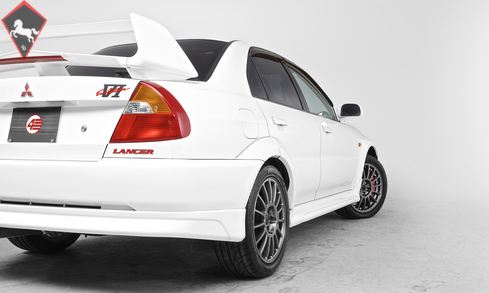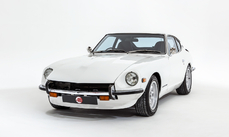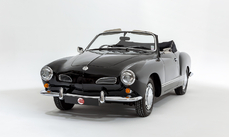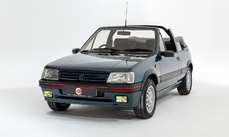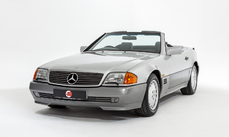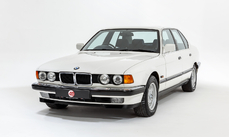Mitsubishi Lancer Evo VI 1999
Allgemeine Beschreibung :
A brilliant Evolution VI, with just 26k miles from new.
MODEL HISTORY
The Mitsubishi Lancer Evolution is a high performance sports car manufactured by Mitsubishi Motors that is based on the standard Lancer. There have been ten official versions to date, and the designation of each model is most commonly a Roman numeral. All use two litre, turbocharged engines and all-wheel drive systems.
The Evolution was originally intended only for Japanese markets, but demand on the "grey import" market led the Evolution series to be offered through Ralliart dealer networks in the United Kingdom and in various European markets from around 1998. Japanese-spec cars were limited by a gentlemen's agreement to advertise no more than 276hp, a mark already reached by Evolution IV. Therefore, each subsequent version has unofficially evolved above the advertised power figures, with the Japanese-spec Evolution IX reaching an alleged output of around 317hp.
The Evolution VI was produced from January 1999 until March 2001. The improvements over its predecessor mainly focused on cooling and engine durability. It received a larger intercooler, larger oil cooler, and new pistons. The Evolution VI received new bodywork yet again, with the most easily noticeable change being within the front bumper where the huge fog lights were reduced in size and moved to the corners for better airflow.
Great rally success was achieved in the WRC Rallies from 1996-1999 thanks to the legendry Finn Tommi Makinen for clinching the drivers titles in this period and help from team mate Richard Burns for clinching the constructors championship for the first, and thus far only time in 1998.
Equipment
Air conditioning, Touchscreen CD/DVD player, Momo steering wheel, Recaro seats, Electric folding mirrors, Electric windows, Boost gauge, Turbo timer, Mitsubishi wind deflectors, Mitsubishi carpet mats, Tinted rear windows, Front and rear strut braces, Spare key.
EXTERIOR
Unlike most, this Evo VI has led a coveted life away from racetracks and as such looks brilliant with its glossy white exterior. It still wears its original coat of paint that remains in excellent condition, completely free of any dents, scratches, or imperfections. There is no corrosion to the bodywork whatsoever, with the underside equally clean.
All the plastic trim and window rubbers retain a factory-fresh matte black finish, and the lenses remain crystal clear. An interesting fact on the Evo VI is that it boasted the largest adjustable rear spoiler before the regulations were changed for a smaller single wing on the Evo VII.
INTERIOR
The new car theme continues on the inside. Opening the door reveals perfectly clean door cards and wear-free upholstery. The factory Recaro seats are excellent and free from any signs of use, and the dash presents well without the smallest scratch.
The carpets too are pristine, protected by a full set of Mitsubishi mats, and the boot area is equally spotless. The hugely practical interior also boasts a touchscreen CD/DVD player with SD card slot, as well as a turbo pressure gauge to ensure correct and safe running.
ENGINE & TRANSMISSION
The mighty two-litre DOHC turbocharged engine produces 276hp and rockets the Lancer from 0-60 in well under five seconds. Benefitting from the addition of a strut brace, the engine bay remains in great order with nothing untoward to note.
Despite its high-performance credentials, the Lancer still drives with typical Japanese-car ease; operating smoothly at low speeds before launching into ferocious acceleration at anything above 4000 rpm.
WHEELS, TYRES & BRAKES
The Evo VI sits on the correct 17-inch OZ Racing alloys, which are in excellent condition having been refurbished in a darker shade of grey. They are present without the tiniest chip and are shod in a brand new set of Bridgestone Potenza tyres all round.
The bright red Brembo calipers appear new between the spokes, and the discs show plenty of life left.
HISTORY FILE
First registered in February of 1999 this Lancer has covered a mere 26,423 miles to date. Having previously resided in a dry climate, the car was recently imported into the UK where all duties and taxes have since been paid.
http://www.4starclassics.com/mitsubishi-lancer-evo-vi-for-sale/
1999 Mitsubishi Lancer Evo VI is listed verkauft on ClassicDigest in Kingsley by 4 Star Classics for £14995.
Fakten der Auto
Karosserietyp : Auto Marke : Mitsubishi Modell : Lancer Ausführung : Evo VI Hubraum : 2.0 Modelljahr : 1999 Karosstyp : Rasse/Rallye-Auto Lage : Hampshire Fahrzeug Anmeldung : Normal
Verkauft
Angaben Zum Verkäufer
Verkauft
People who viewed this Mitsubishi Lancer also viewed similar Mitsubishi listed at ClassicDigest
Other cars listed for sale by this dealer
über Mitsubishi
Mitsubishi: Eine Reise durch die Geschichte (bis in die 1980er Jahre)1. Frühe Anfänge:
Gründung: Mitsubishis Wurzeln reichen zurück zur Gründung einer Schifffahrtsfirma durch Yataro Iwasaki im Jahr 1870.
Diversifizierung: Das Unternehmen expandierte in den Bergbau, den Schiffbau und andere Branchen, was die Grundlage für die Mitsubishi Group bildete.
2. Erste Automobilunternehmungen:
Erste Automobilproduktion: Mitsubishi wagte sich im frühen 20. Jahrhundert in die Automobilproduktion.
Modell-A: Im Jahr 1917 führte Mitsubishi sein erstes Serienfahrzeug, das Modell-A, ein, Japans erstes Serienautomobil.
3. Nachkriegsära:
Umstrukturierung: Nach dem Zweiten Weltkrieg stand Mitsubishi vor Herausforderungen, durchlief jedoch eine Umstrukturierung und nahm die Automobilproduktion wieder auf.
Produktion von Jeeps: Anfangs konzentrierte sich Mitsubishi auf die Produktion von Jeeps und trug erheblich zur Wiederbelebung der japanischen Automobilindustrie bei.
4. Meilenstein-Modelle:
Mitsubishi 500: 1960 eingeführt, war der Mitsubishi 500 ein Kompaktfahrzeug, das dazu beitrug, kleinere Fahrzeuge in Japan populär zu machen.
Mitsubishi Colt 600: 1962 herausgebracht, war der Colt 600 ein Kleinwagen, der dazu beitrug, Mitsubishis Präsenz auf dem Automobilmarkt zu stärken.
5. Globale Expansion und die 1970er Jahre:
Partnerschaften: Mitsubishi schloss Partnerschaften mit internationalen Automobilherstellern und erweiterte damit seinen Einfluss über Japan hinaus.
Galant und Lancer: Modelle wie der Galant und der Lancer gewannen in den 1970er Jahren an Popularität und zeigten Mitsubishis Engagement für Innovation und Leistung.
6. Technologische Fortschritte:
Mitsubishi Astron-Motor: In den 1970er Jahren eingeführt, wurde der Astron-Motor zum Markenzeichen von Mitsubishi-Fahrzeugen und war bekannt für seine Langlebigkeit und Effizienz.
7. Höhepunkt der 1980er Jahre:
Mitsubishi Pajero: Anfang der 1980er Jahre eingeführt, markierte der Pajero (Montero in einigen Märkten) Mitsubishis Einstieg in das SUV-Segment und wurde ein globaler Erfolg.
Starion: Der Starion, Mitte der 1980er Jahre eingeführt, war ein Sportwagen, der Mitsubishis Leistungsfähigkeit demonstrierte.
8. Klassische Modelle von Mitsubishi der 1980er Jahre:
Mitsubishi Delica: Der Delica, erstmals in den 1960er Jahren eingeführt, gewann in den 1980er Jahren an Popularität und war ein vielseitiger Van in verschiedenen Konfigurationen.
Mitsubishi Mighty Max: Dieser kompakte Pickup-Truck war bekannt für seine Robustheit und Praktikabilität.
Mitsubishi Mirage: Der Mirage, in Hatchback- und Limousinen-Versionen erhältlich, wurde aufgrund seiner Kraftstoffeffizienz und Zuverlässigkeit beliebt.
Mitsubishis Reise durch die 1980er Jahre spiegelt ihre Entwicklung von einem vielfältigen Konglomerat zu einem bedeutenden Akteur in der globalen Automobilindustrie wider. Das Jahrzehnt brachte die Einführung von ikonischen Modellen mit sich, die Mitsubishis Ruf für Innovation und Leistung stärkten.
